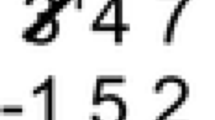Abstract
A series of studies were carried out into the development of number concepts in 7–9 year old low attaining pupils. The aims of the work were:
-
(i)
To identify a framework which describes children's orders of acquisition of number concepts.
-
(ii)
To develop a diagnostic assessment instrument capable of describing children's understanding of number
-
(iii)
To devise, carry out and evaluate teaching and activities which would extend the children's understanding of number.
Achievement of the first two aims is described in an earlier paper (Denvir and Brown, 1986a). The present paper describes how the third aim was achieved in two teaching studies. Both were based on the descriptive framework and children's performances in the diagnostic assessment interview. However the two studies differed in approach. In the pilot study pupils were taught individually and specific teaching points were selected for each child. In contrast to this, children who participated in the main study were taught as part of a group whose members had reached a similar level of understanding but had acquired slightly different skills. Consequently the focus was less on teaching specific points and more on linking different aspects of certain concepts.
In both studies the pupil's performances improved between pre and post tests, suggesting that the framework and the pupils' performances in the diagnostic assessment interviews may provide a useful basis for designing a remedial teaching programme.
Similar content being viewed by others
References
Ausubel, D. P., Novak, J. D. and Hanesian, H.: 1978, Educational Psychology: A Cognitive View, Rinehart and Winston, New York.
Bryant, P. E.: 1982, ‘The role of conflict and of agreement between intellectual strategies in children's ideas about measurement’, British Journal of Psychology 73, 243–251.
Denvir, B. and Brown, M.: 1986a, ‘Understanding of number concepts in low attaining 7–9 year olds: Part I. Development of descriptive framework and diagnostic instrument’, Educational Studies in Mathematics 17, 15–36.
Denvir, B., Stolz, C., and Brown, M.: 1982, ‘Low attainers in mathematics 5–16: Policies and practices in schools’, Schools Council Working Paper 72, Methuen Educational, London.
Dienes, Z. P.: 1960, Building up Mathematics, Hutchison, London.
Lawler, R. W.: 1981, ‘The progressive construction of mind’, Cognitive Science 5, 1–30.
Piaget, J.: 1952, The Child's Conception of Number, Routledge and Kegan Paul, London.
Riley, M. S., Greeno, J. G. and Heller, J. I.: 1983, ‘Development of children's ability in arithmetic’, in H. P.Ginsburg (ed.), The Development of Mathematical Thinking, 153–196, Academic Press, New York.
Schaeffer, B., Eggleston, V. H., and Scott, J. L.: 1974, ‘Number development in young children’, Cognitive Psychology 6, 357–379.
Skemp, R. R.: 1976, ‘Relational understanding and instrumental understanding’, Mathematics Teaching 77, 20–26.
Author information
Authors and Affiliations
Rights and permissions
About this article
Cite this article
Denvir, B., Brown, M. Understanding of number concepts in low attaining 7–9 year olds: Part II. The teaching studies. Educ Stud Math 17, 143–164 (1986). https://doi.org/10.1007/BF00311518
Issue Date:
DOI: https://doi.org/10.1007/BF00311518




